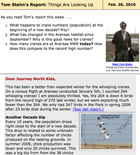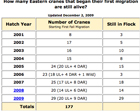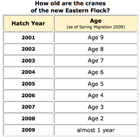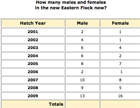“Things are looking up for this very endangered species,” reports Tom Stehn from the main flock’s Texas wintering grounds where the count is 263 Whooping cranes and plenty of rain. Three Eastern cranes may have begun migration with sandhill cranes. The crane-kids, content in Florida, learned to eat blue crabs. Meet the flock’s most productive pair in our slideshow and compare the two flocks we're tracking. Discover why 929 has a different VHF transmitter (see photo) from all the others.
Today's Report Includes:
- News: Field Reports From Texas and Florida
- Weather: How Do Cranes Cope With Cold?
- Slideshow: Cranes to Know
- Journal: Take Stock of the Flocks
- Coming Soon: Track the Migration
- Links: Helpful Resources to Explore

Crane
929 is the only one with a wide, white VHF transmitter.
Why?
Photo:
Sara Zimorski, ICF
 |
 |
 |
| Migration
is Coming! In Tennessee a few Whooping cranes who were with sandhill cranes began their northward migration with the sandhills. (See DAR: 27-05, 28-05, and 33-05.) |
Latest
News! Western Flock:Texas Tom Stehn has good news after last year's tough winter for the cranes. |
Latest
News! Class of 2009: Florida Sara has tips for reading leg bands and Brooke tells how the crane-kids first faced blue crabs. |
 |
Are these one-legged cranes? No. Lawn ornaments? No. They are adult male #506 and seven 2009 Direct Autumn Release (DAR) juveniles trying to stay warm in Jefferson County, Kentucky! They've each tucked one foot into their feathers to keep warm. The group moved to Adair County, Kentucky, reports the tracking team. Is it warmer there? Are
you surprised that cranes can pull those long legs up into their
feathers? They do it in flight when it's cold, too. Click to
see what it looks like! Pilot Joe Duff shows us a close
view. Photo: Eddie
and Jennifer Huber |
We don't know as many details about the lives of the wild natural flock as we do about the captive-born ultralight-led flock. But Tom Stehn's memory is full of wonderful stories about the cranes he's come to know over the past 30 years, like the pair he calls Al and Diane. Meet them in the slide show and see why they're so great. Then answer:
- In 17 nesting attempts between 1993 and 2009, this pair has brought young to Aransas __ times. They have brought __ single chicks and __ sets of twins, for a total of __ chicks.
- What did you discover to help explain why the crane population grows so slowly?
You
learned something about how the Western flock grows in Tom Stehn's
report and saw the population graph. How does the number of
birds in the Western flock
compare to the Eastern flock?
What
other differences
between these two flocks can you list? To help you answer that,
first investigate three questions about the new Eastern flock
with these pages. How do you think each flock will change during
your lifetime? Write in your journal. |
||
 |
||
| How old are the cranes in the flock now? | How many males and females are there? | |
Starting
in March, you'll see the migration progress of both flocks —
ALL the world's migratory Whooping cranes — live
on our MapServer! |
||
| migration animation | ||
- Teachers/Overview: Getting Started
- Image of the Week: Different Colored Transmitters
- Field Report: From Texas Wintering Grounds
- Field Report: From Florida Wintering Grounds
- Lesson: Feeling Blue and Crabby: Whooping Crane Winter Diet
- Slideshow: Meet Al and Diane: A Productive Pair
- Lesson: The Challenges of Whooping Crane Survival: Learning from Life Histories
- Photo Study: Winter Diet
- Resource: Quick-View Leg Band Chart: Class of 2009
- About
the Bands: Leg
Bands: Codes and Colors
Can you identify the cranes?
The Next Whooping Crane Migration Update Will Be Posted on March 12, 2010.








